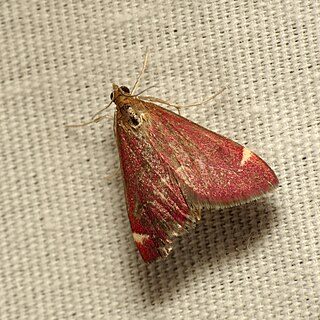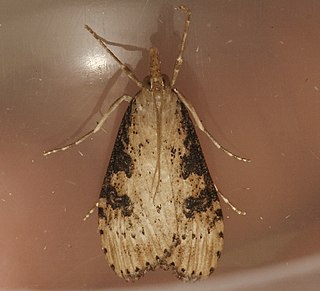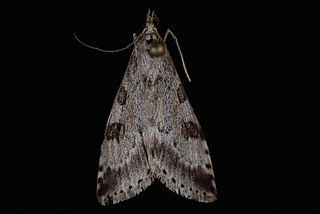
Chrysothamnus, known as rabbitbrush, rabbitbush, and chamisa, are shrubs in the sunflower family. The native distribution is in the arid western United States, Canada, and northern Mexico. It is known for its bright white or yellow flowers in late summer.
Evergestis funalis is a moth in the family Crambidae. It was described by Augustus Radcliffe Grote in 1878. It is found in North America, where it has been recorded from Alaska, Arizona, British Columbia, California, Colorado, Nevada, Oregon, Utah and Washington.
Evergestis palousalis is a moth in the family Crambidae. It was described by Munroe in 1974. It is found in North America, where it has been recorded from Alberta, British Columbia, California, Colorado, Nevada, Oregon and Utah.
Evergestis vinctalis is a moth in the family Crambidae. It was described by William Barnes and James Halliday McDunnough in 1914. It is found in North America, where it has been recorded from Alberta, Arizona, British Columbia, California, Colorado, Kansas, Montana, Nevada, New Mexico, Texas and Wyoming.
Stegea salutalis is a moth in the family Crambidae. It is found in North America, where it has been recorded from Arizona, British Columbia, California, Colorado, Montana, New Mexico, Oregon, Texas and Utah. In the south, the range extends to north-western Mexico.
Loxostege sierralis is a moth in the family Crambidae. It was described by Munroe in 1976. It is found in North America, where it has been recorded from British Columbia, Saskatchewan, Washington, Utah, Oregon and California.

Pyrausta fodinalis is a moth in the family Crambidae. It was described by Julius Lederer in 1863. It is found in North America, where it has been recorded from British Columbia to Quebec and the north-eastern United States. It is also present in California, Nevada, Colorado and Wyoming. The habitat consists of undisturbed prairie and grassland areas.

Pyrausta grotei is a moth in the family Crambidae. It was described by Eugene G. Munroe in 1976. It is found in North America, where it has been recorded from Washington, Oregon, Montana, California, Utah, Colorado, Wyoming, Nevada, Arizona and Texas.

Eudonia spaldingalis is a moth in the family Crambidae. It was described by William Barnes and James Halliday McDunnough in 1912. It is found in North America, where it has been recorded from Alberta, Arizona, British Columbia, California, Colorado, Montana, Nevada, New Mexico, Utah and Wyoming.
Eudonia torniplagalis is a moth in the family Crambidae. It was described by Harrison Gray Dyar Jr. in 1904. It is found in North America, where it has been recorded from South Dakota, the Rocky Mountains, the mountains of the south-western United States and from British Columbia to southern California.
Udea abstrusa is a moth in the family Crambidae. It was described by Munroe in 1966. It is found in North America, where it has been recorded from Alberta, British Columbia, Colorado, New Mexico, the Northwest Territory, Washington and Wyoming.
Udea beringialis is a moth in the family Crambidae. It was described by Munroe in 1966. It is found in North America, where it has been recorded from Alaska, Alberta, British Columbia, Manitoba and the Yukon Territory.
Udea brevipalpis is a moth in the family Crambidae. It was described by Munroe in 1966. It is found in North America, where it has been recorded from California, Colorado and Utah.
Udea cacuminicola is a moth in the family Crambidae. It was described by Munroe in 1966. It is found in North America, where it has been recorded from Colorado and Wyoming.
Udea derasa is a moth in the family Crambidae. It was described by Munroe in 1966. It is found in North America, where it has been recorded from British Columbia and Utah.

Udea livida is a moth in the family Crambidae. It was described by Munroe in 1966. It is found in North America, where it has been recorded from British Columbia, Washington and Utah.
Udea radiosalis is a moth in the family Crambidae. It was described by Möschler in 1883. It is found in North America, where it has been recorded from Alberta, Arizona, California, Montana, Nevada, Newfoundland and Labrador and Utah.
Udea turmalis is a moth in the family Crambidae. It was described by Augustus Radcliffe Grote in 1881. It is found in North America, where it has been recorded from Alberta, Arizona, British Columbia, California, Colorado, Idaho, Manitoba, Montana, Nevada, New Mexico, Utah and Washington.

Udea washingtonalis, the Washington udea moth, is a moth in the family Crambidae. It was described by Augustus Radcliffe Grote in 1882. It is found in North America, where it has been recorded from Alaska, British Columbia, California, Montana and Washington.
Chionodes metoecus is a moth in the family Gelechiidae. It is found in North America, where it has been recorded from southern British Columbia, Montana, Oregon, Colorado, Utah, Arizona, New Mexico, Nevada and California.






